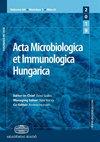Characterization of disinfectant susceptibility profiles among clinical isolates of Acinetobacter baumannii in Ardabil, Iran
IF 1.6
4区 医学
Q4 IMMUNOLOGY
引用次数: 0
Abstract
Abstract Antimicrobial disinfectants have been extensively used to control hospital-acquired infections worldwide. Prolonged exposure to bacteria could promote resistance to antimicrobial disinfectants. This study evaluated the antimicrobial activity of four commonly used disinfectants; triclosan, chlorhexidine digluconate, benzalkonium chloride, and formaldehyde against Acinetobacter baumannii clinical isolates. This study also determined the prevalence and association of efflux pumps encoding genes qacE , qacED1 , emrA , and aceI with tolerance to disinfectants. A total of 100 A. baumannii isolates were included in the current study. The antimicrobial disinfectants' minimum inhibitory concentration (MIC) was determined using an agar dilution method. Genes involved in resistance to disinfectants were investigated by PCR method. The benzalkonium chloride MICs ranged between 32 and 128 μg mL −1 , chlorhexidine digluconate 8–64 μg mL −1 , triclosan 1–32 μg mL −1 , and formaldehyde 128 μg mL −1 . Overall, the highest MIC 90 value was identified for formaldehyde (128 μg mL −1 ), followed by benzalkonium chloride and chlorhexidine digluconate (64 μg mL −1 , each one) and triclosan (4 μg mL −1 ). In the present study, the qacE, qacED1, emrA , and aceI genes were found in 91%, 55%, 100%, and 88% of isolates, respectively. The qacG gene was not identified in our A. baumannii isolates. The qacED1 gene was associated with higher MICs for all disinfectants tested ( P < 0.05), while the qacE and aceI genes were associated with higher MICs for benzalkonium chloride and chlorhexidine. This study indicated that triclosan is the most effective disinfectant against A. baumannii isolates.伊朗阿达比尔鲍曼不动杆菌临床分离株消毒剂敏感性分析
抗菌消毒剂已被广泛用于控制世界各地的医院获得性感染。长时间接触细菌会促进对抗菌消毒剂的耐药性。本研究评价了四种常用消毒剂的抗菌活性;三氯生、二光酸氯己定、苯扎氯铵和甲醛对鲍曼不动杆菌临床分离株的抑制作用。本研究还确定了编码基因qacE、qacED1、emrA和aceI的外排泵的普遍性及其与消毒剂耐受性的关联。本研究共纳入100株鲍曼不动杆菌分离株。采用琼脂稀释法测定抗菌消毒剂的最低抑菌浓度(MIC)。采用聚合酶链反应(PCR)方法对消毒剂抗性相关基因进行了研究。苯扎氯铵的mic值为32 ~ 128 μg mL - 1,二光酸氯己定8 ~ 64 μg mL - 1,三氯生1 ~ 32 μg mL - 1,甲醛128 μg mL - 1。总体而言,甲醛的MIC 90值最高(128 μg mL−1),其次是氯化苄扎铵和二光酸氯己定(各64 μg mL−1)和三氯生(4 μg mL−1)。在本研究中,qacE、qacED1、emrA和aceI基因分别在91%、55%、100%和88%的分离株中发现。在我们分离的鲍曼不动杆菌中未发现qacG基因。qacED1基因与所有消毒剂的高mic相关(P <0.05),而qacE和aceI基因与苯扎氯铵和氯己定的高mic相关。本研究表明,三氯生是对鲍曼不动杆菌分离株最有效的消毒剂。
本文章由计算机程序翻译,如有差异,请以英文原文为准。
求助全文
约1分钟内获得全文
求助全文
来源期刊

Acta microbiologica et immunologica Hungarica
IMMUNOLOGY-MICROBIOLOGY
CiteScore
2.30
自引率
13.30%
发文量
36
审稿时长
>12 weeks
期刊介绍:
AMIH is devoted to the publication of research in all fields of medical microbiology (bacteriology, virology, parasitology, mycology); immunology of infectious diseases and study of the microbiome related to human diseases.
 求助内容:
求助内容: 应助结果提醒方式:
应助结果提醒方式:


